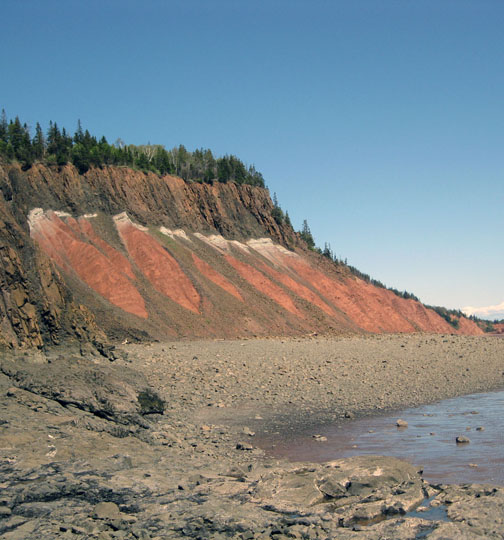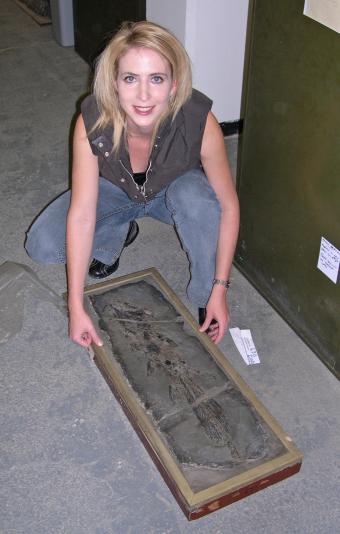PROVIDENCE, R.I. [Brown University] — A shade more than 200 million years ago, the Earth looked far different than it does today. Most land on the planet was consolidated into one continent called Pangea. There was no Atlantic Ocean, and the rulers of the animal world were crurotarsans – creatures closely related to modern crocodiles.
Yet the Earth stood on the cusp of an epic shift in climate, and the reign of the dinosaurs was about to begin. Now, an international scientific team led by Brown University paleobiologist Jessica Whiteside has explained what led to the dinosaurs’ rise as the Triassic Period ended. In a paper published in the Proceedings of the National Academy of Sciences, the scientists constructed a climate record marking the Triassic-Jurassic boundary by combining fossil evidence of plant and animal extinctions with the carbon signature found in the wax of ancient leaves and wood found in lake sediments intermixed with basalts, marking the volcanic activity.
With those evidentiary threads, the researchers found strong support that massive, widespread volcanic eruptions led to a spike in atmospheric carbon dioxide and other greenhouse gases that wiped out half of plant species and marked the end of the Triassic, one of the five great mass extinctions of Earth history.
The team also established through the fossil record that the abrupt rise in atmospheric gases decimated crurotarsans, which had competed vigorously with the earliest dinosaurs during the Triassic. Thanks to the climatic catastrophe, those early, small dinosaurs were freed from their main competitors to become the dominant force in the animal world.
“The big thing is many people have heard why dinosaurs went extinct,” said Whiteside, assistant professor of geological sciences, “but the question why they came to be is much more exciting.”
What scientists know is that more than 200 million years ago, the supercontinent Pangea broke up when the North American and the African plates began to drift apart. As the two plates parted, creating the basin that would become the Atlantic Ocean, fissures cleaved the area, triggering massive outflows of lava covering more than 9 million square kilometers (3.5 million square miles), an area roughly equal to the continental United States. Scientists call this area the Central Atlantic Magmatic Province (CAMP). The volcanic eruptions lasted about 600,000 years, a length of time that Whiteside estimated in a 2007 paper in Palaeogeography, Palaeoclimatology, Palaeoecology.
The researchers zeroed in on rift basins preserving the CAMP to figure out precisely what happened to the climate and to plants and animals. The team, including researchers from Academia Sinica in Taiwan, Columbia University, and the Woods Hole Oceanographic Institution, analyzed fossils and carbon signatures from two ancient basins in the northeast United States — the Newark and Hartford basins — as well as a basin in England. At these sites, the researchers found evidence where fossilized sediments from lakes that dotted Pangea before the plates’ separation were preserved between lava flows. The team dated the oldest flows to 201.4 million years ago, providing an upper limit to when volcanism began.
Those fossils told a clear tale: For plants, pollen counts combined with the carbon record (the ratio of C12 and C13, two carbon isotopes) showed half the flora species in the Triassic perished in the volcanism that marked the end of the period. It also showed a spike in fern spores around the time of the first lava flows, which makes sense as ferns are among the first plant species to return in an environment scarred by volcanism.

Image: Jessica. H. Whiteside/Brown University
For animals, the scientists linked footprints previously found in rocks in the Hartford and Newark basins to establish that crurotarsans perished in the mass volcanism that marked the end of the Triassic. After the lava flows, the “fossil record for crurotarsans is nearly completely gone,” Whiteside said. Freed from their main competitor, early theropods — a category including all meat-eating dinosaurs from velociraptors to Tyrannosaurus rex — became dominant. Evidence for the rise was documented in a paper published in 2002 by Paul Olsen (second author on the PNAS paper) that shows theropod footprints after the mass extinction at the end of the Triassic had become much larger, corresponding to larger body sizes.
Why did the early dinosaurs survive the volcanism that extinguished the Triassic crurotarsans? “They had the blind luck of being unwittingly adapted to get through that climate catastrophe,” Whiteside said. “How they did is quite difficult to explain.”
While previous research on end-Triassic mass extinctions has been done in other regions, such as Greenland, this paper marked the first time that scientists had gathered and calibrated evidence from the CAMP, said Olsen, a paleontologist who has studied mass extinction events for three decades at Columbia.
“There are dozens of papers claiming to show the connection between carbon isotopes excursions in the CAMP,” Olsen said, “but this is the only study that has ever shown isotope excursions from the same place that the lava flows were present.”
“It’s not that we’re the first people to say there’s a link” (between volcanism and end-Triassic mass extinction), Whiteside added, “but we’re the first people to document it.”
Other authors on the paper are Timothy Eglinton from the Department of Marine Geology and Geophysics at the Woods Hole Oceanigraphic Institute, Michael Brookfield at the Institute of Earth Sciences Academia Sinica in Taiwan, and Raymond Sambrotto from the Lamont-Doherty Earth Observatory at Columbia.
The National Science Foundation funded the research.

